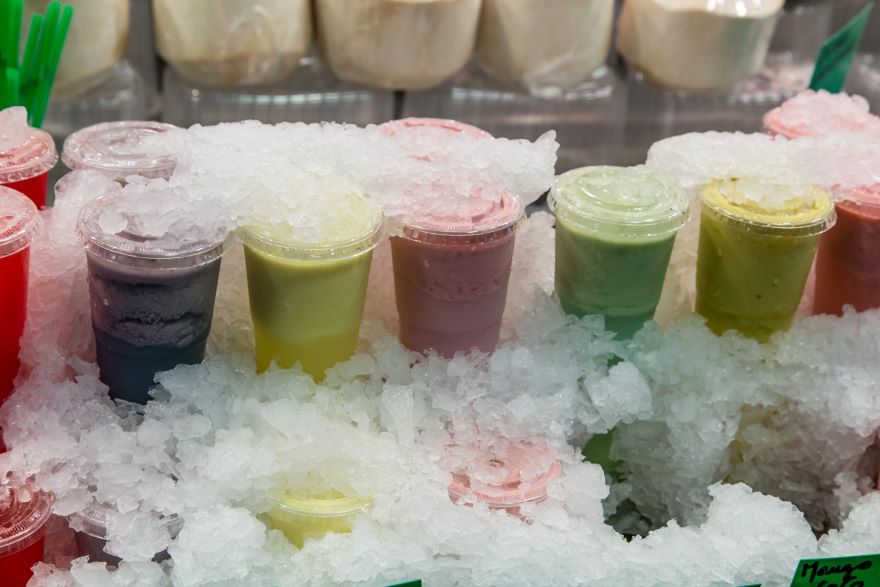How To Store Smoothies
Smoothies combine fruits, vegetables, and nutritious ingredients in one convenient and delicious drink. Storing smoothies can be a concern for those preparing them ahead or with leftovers. Proper storage techniques are essential to maintaining the taste, texture, and nutritional content of your smoothie.
The key to storing smoothies is finding the right methods and materials to keep the mixture fresh and prevent it from separating or spoiling. Different storage techniques can be used depending on how long the smoothie is to be kept and personal preferences. While some people prefer keeping their smoothies refrigerated, others might choose to freeze them for longer periods. Properly storing smoothies ensures you can enjoy their delicious and nutritious benefits anytime.
Key Takeaways
- Proper storage methods are crucial for maintaining smoothie taste, texture, and nutrition.
- Choosing the right containers and materials can prevent separation and spoilage.
- Storage techniques to be used, such as refrigeration or freezing, depend on personal preferences and timing needs.
Why Storing Smoothies Matters
As a smoothie enthusiast, I’ve come to understand the importance of proper storage for maintaining their freshness and nutritional value. You can enjoy smoothies later as a convenient and nutritious meal or snack option when stored correctly. In this section, I will discuss why storing your smoothies properly is crucial, including the problem of oxidation, preserving nutrients, and preventing microbial growth.
First and foremost, oxidation is a significant factor that influences the quality and taste of stored smoothies. Nutrients in your smoothie undergo oxidation when exposed to air. This can lead to a loss of nutrients and a decline in flavor. Prevent oxidation and keep smoothies fresh longer with airtight storage methods and minimal air exposure.
Another reason why storing smoothies is important is to preserve the nutrients present in the ingredients. Vitamins, minerals, and other beneficial compounds in smoothies can degrade over time. Storing them properly helps retain these nutrients, ensuring I receive the maximum health benefits when I consume my smoothie later.
Lastly, proper storage plays a vital role in preventing microbial growth.Incorrect storage of smoothies can cause bacteria, mold, and microorganisms, posing health risks. Freezing below 20°F prevents microbial growth and ensures smoothie safety for consumption.

Final Thoughts On How To Store Smoothies
In conclusion, storing smoothies properly is crucial for maintaining their freshness, taste, and nutritional value. By doing so, I can enjoy delicious and nourishing smoothies any time without compromising their quality.
Choosing the Right Containers and Materials
The container used for storing smoothies affects freshness, taste, and nutritional value. In this section, I’ll discuss the benefits and drawbacks of glass versus plastic containers, as well as the importance of reusable options.
Glass versus Plastic
Plastic and glass containers each have their own set of pros and cons, which I will briefly outline here.
Glass Containers
- Pros: Glass is non-porous, meaning it doesn’t absorb flavors or odors, making it an excellent choice for maintaining the taste of your smoothies. Additionally, glass can be easily cleaned and is less likely to scratch or become cloudy over time.
- Cons: Glass can be heavier, more expensive, and prone to breaking compared to its plastic counterparts.
Plastic Containers
- Pros: Plastic is lightweight, affordable, and less fragile than glass, making it attractive for those who are on-the-go or accident-prone.
- Cons: Be cautious in selecting plastic containers, as many contain BPA, a potentially harmful chemical. Opt for BPA-free plastic containers with secure lids.
Ultimately, it’s important to weigh the benefits and drawbacks of each material to decide what best suits your needs. Regardless of whether you choose glass or plastic, look for containers with a tight seal to prevent air from entering and causing oxidation, which can degrade the taste and nutrient content of your smoothie.
Reusable Containers
Choosing reusable containers is an environmentally-friendly and cost-effective option. Investing in high-quality, durable containers, like Mason jars, means you can cut down on waste and save money by not having to purchase disposable options.
When using reusable containers, be sure to fill them to the brim to limit the amount of air space inside. This can help further prevent oxidation, maintaining the freshness, taste, and nutrients of your smoothie.
Overall, finding the right container for storing your smoothies is crucial in preserving their flavor, freshness, and nutritional value. Consider material, seal quality, and reusability when choosing a container that suits your needs and preferences for storing smoothies.
Prepping Your Ingredients
When it comes to making delicious and healthy smoothies, the key is in the preparation of your ingredients. In this section, I’ll walk you through the necessary steps to ensure your smoothies stay fresh and nutritious.
Washing and Cutting
Before blending your fruits and vegetables, it’s essential to properly wash them to remove any dirt, pesticides, or bacteria. Here’s how I usually do it:
- Rinse fruits and vegetables under cold running water.
- Use a soft brush to clean the surface of firmer produce like apples and cucumbers.
- For leafy greens, fill a bowl with cold water, submerge the leaves, and gently swish them around to clean. Then pat dry with a clean towel.
After washing, it’s time to cut the ingredients into smaller pieces. For fruits like apples, remove the core and slice into smaller chunks. Leafy greens, such as spinach or kale, can be roughly chopped to make blending easier. Make sure to remove any seeds or pits from fruits like cherries or peaches.
Blending Techniques
When it comes to blending, there are a few tricks to achieve the perfect smoothie consistency. Here’s how I do it:
- Start with the liquids: Pour your liquid base (such as water, milk, or juice) into the blender first. This helps to prevent the blender from getting clogged and help solid ingredients blend more easily.
- Layer your ingredients: Next, I add the leafy greens, followed by the fruits and vegetables. Finally, I put any frozen ingredients on top. It helps to create a smooth blending process.
- Pulse before blending: I like to pulse the blender a few times before blending at full speed. This helps to chop the ingredients and ensure a smoother result.
- Blend to your desired consistency: Adjust the blending time to achieve the texture you prefer. If the smoothie is too thick, add more liquid and blend again until you’re satisfied with the result.
By following these steps, I can always ensure the best possible taste and texture in my smoothies. Happy blending!
Storage Techniques
As someone who enjoys smoothies, I’ve experimented with different storage techniques to keep them fresh and tasty. In this section, I will share my knowledge on two effective methods: freezing and refrigerating smoothies.
Freezing Smoothies
When it comes to freezing smoothies, I find it best to pour them into silicone ice cube trays or freezer-safe containers. This approach enables me to retain most of the nutrients and makes it easy to blend the frozen cubes later. Some tips I’ve found helpful when freezing smoothies include:
- Fill containers to the top: This prevents air trapped inside from oxidizing the smoothie and degrading nutrients.
- Label and date containers: This helps me keep track of which smoothies I’ve made and when they might start losing their flavor.
- Thaw before drinking: I prefer letting the frozen smoothie cubes thaw for a few minutes or blending them with liquid for a smoother consistency.
Refrigerating Smoothies
For short-term storage, I often opt for refrigerating my smoothies. Simply following these steps helps me keep my smoothies fresh and enjoyable:
- Use an airtight container: This prevents any unwanted odors or flavors from transferring while in the fridge.
- Consume within 24 hours: While the fridge slows down oxidation, I find it best to consume refrigerated smoothies within a day to ensure maximum freshness.
- Give it a good shake before drinking: Settling might occur when storing smoothies, so I make sure to give the container a thorough shake to mix everything back together.
By utilizing these storage techniques, I can easily make smoothies in bulk and enjoy them at my convenience without sacrificing flavor or nutrition.
Storing Smoothies for Long Periods
I have found that the best way to store smoothies for longer periods is by freezing them. This helps to preserve both their taste and nutritional value. Before freezing your smoothie, make sure it cools down to room temperature. Always use a freezer-safe container to ensure your smoothie stays fresh and doesn’t develop an unpleasant texture.
In my experience, Mason jars are an excellent choice for storing smoothies in the freezer. The glass is sturdy and the screw-on lids create an airtight seal, keeping your smoothie from developing freezer burn. Alternatively, you can use high-quality, BPA-free plastic containers or insulated tumblers with airtight seals to keep your smoothie fresh.
When I freeze my smoothies, I prefer to leave a little room at the top of the container for expansion during freezing. This helps prevent any spills or cracked containers. Label smoothies with date and ingredients to track storage time and identify them easily later.
To enjoy your frozen smoothie, simply move it from the freezer to the refrigerator the night before you plan to consume it. This will give it ample time to thaw. If you’re in a hurry, you can also place the container in a bowl of warm water to speed up the thawing process.
Remember, storing smoothies in the freezer is a convenient and effective method to enjoy your favorite blends at a later time. By following these tips, you can maintain their taste and nutritional quality.
Reviving Your Stored Smoothies
When it’s time to enjoy your stored smoothies, there are a few steps I follow to ensure the best taste and texture. In this section, I’ll discuss reblending and different thawing methods to bring your smoothie back to life.
Reblending
If I’ve stored my smoothie in the fridge, I often find the texture and separation can be a bit off. To fix this, I simply pour the smoothie into my blender and give it a quick blend to ensure a consistent texture. Depending on the ingredients and storage time, I might need to adjust the thickness by adding a splash of liquid, such as water, milk, or juice. After blending, I give it a taste and adjust the sweetness or flavor if needed. Reblending is an easy and effective way to restore the consistency and flavor of a stored smoothie.
Thawing Methods
When I store smoothies in the freezer, the key to getting the ideal texture and taste is the thawing process. I’ve learned there are a few different methods I can use when thawing my frozen smoothies:
- Fridge Thawing: I transfer the smoothie container from the freezer to the fridge and let it thaw for several hours or overnight. This slow thawing method helps to maintain the flavor and prevents ice crystals from forming in my smoothie.
- Room Temperature Thawing: If I’m in a hurry, I place my frozen smoothie on the countertop to thaw at room temperature. Depending on the container size and room temperature, it usually takes around 1 to 2 hours for my smoothie to reach a drinkable consistency.
- Quick Thawing: For an even faster thawing method, I place my frozen smoothie in a bowl of lukewarm water. This helps to speed up the thawing process and gets my smoothie ready to drink in about 30 minutes. However, it’s important not to use hot water, as it can negatively affect the flavor and nutrient content of my smoothie.
Once my smoothie has thawed, I give it a good stir or use the reblending method to ensure a consistent texture before enjoying it. By following these steps, I can easily revive my stored smoothies and savor their delicious taste and nutrients.
Potential Issues and Solutions On How To Store Smoothies
One potential issue with storing smoothies is the oxidation process that can degrade the nutrients, making your smoothie less nutritious. To solve this problem, I make sure to store my smoothies in an airtight container. This helps reduce the amount of air trapped inside, thus preserving the nutrients (source).
Another concern when storing smoothies is the potential for toxin leaching from plastic containers. I prefer using BPA-free mason jars for storing my smoothies as they do not have the toxic elements commonly found in cheap plastic containers. This ensures a safe and worry-free drinking experience (source).
When it comes to the length of time I can store my smoothie, refrigerated smoothies are best consumed within a day to maintain their freshness. For a longer storage period, I opt to freeze my smoothies in single servings. This allows me to enjoy them at a later time without losing much of their nutritional value. Just make sure to use an airtight container when freezing to keep water crystals and freezer burn to a minimum (source).
Lastly, it’s important to keep your blender and other equipment clean to prevent residual flavors and odors from spoiling your fresh smoothie. I always ensure that my blender is properly cleaned before use, so that the taste of my new smoothie isn’t affected by old residue (source).
Summary On How To Store Smoothies
I’ve gathered valuable information on how to properly store smoothies to maintain their freshness and taste. Smoothies can be stored in the refrigerator or freezer, depending on how long you plan to store them. Here are some methods that I have discovered to be effective in maintaining the quality of smoothies during storage.
The refrigerator is suitable for short-term storage, typically for a few hours or until the next day. I recommend using airtight containers like mason jars to store your smoothies in the fridge. Fill the container all the way to the top to prevent air from being trapped in the container.
For storing smoothies longer, such as a few days, the freezer is the best option. Freezing smoothies in airtight containers ensures minimal exposure to oxygen, thus reducing the risk of freezer burn and ice crystal formation. Some practical options for freezer storage include freezer-safe containers, ice cube trays, mason jars, ziplock bags, and reusable silicone bags. Freezing smoothies as popsicles is another fun and tasty alternative.
Keep in mind that smoothies can last up to 3-4 days in the fridge if stored properly; however, they will taste best if consumed within 24 hours. When it comes to storing a smoothie at room temperature, it is advised to consume it as soon as possible, preferably within 2-3 hours, due to oxidation and potential spoilage.
Following these guidelines, you can now confidently and effectively store smoothies to enjoy them later without compromising their flavor and nutritional value.
Frequently Asked QuestionsAdvised to consume a smoothie stored at room temperature within 2-3 hours due to oxidation and potential spoilage.
- How long can homemade smoothies be refrigerated? When it comes to homemade smoothies, you can refrigerate them for up to 24-48 hours, or 1-2 days, in a clean container like a mason jar. Make sure to store the smoothie in a sealed container to maintain its freshness and to prevent absorbing any other flavors from the refrigerator.
- What is the best method for freezing smoothies? Freezing smoothies is a great way to keep them fresh for longer periods. To do this, pour your smoothie into an airtight, freezer-safe container, leaving some room for expansion, and freeze. When you’re ready to consume the frozen smoothie, defrost it overnight in the refrigerator as suggested by this source.
- How long do smoothies last in the freezer? Smoothies can last up to three months in the freezer when stored in a clean, airtight container, as mentioned by this source. Just remember to defrost the smoothie in the refrigerator overnight before enjoying it.
- What containers are recommended for storing smoothies? For storing smoothies, I recommend using BPA-free mason jars or any other airtight containers that are made from food-safe materials. The main advantage of using mason jars is their glass construction, which prevents toxins from leaching into your smoothies, providing a safe and worry-free experience, as explained here.
- Are glass jars safe for freezing smoothies? Glass jars can be safe for freezing smoothies, provided they are made from freezer-safe or tempered glass. Be sure to leave enough room at the top of the jar for the smoothie to expand during the freezing process to avoid breaking the jar. If you’re unsure about whether a jar is suitable for freezing, refer to the manufacturer’s instructions or opt for a safer alternative, like a BPA-free plastic container.


 Previous Post
Previous Post Next Post
Next Post